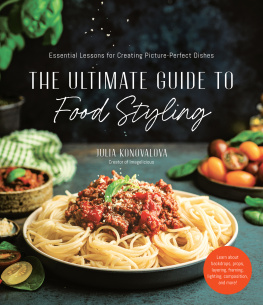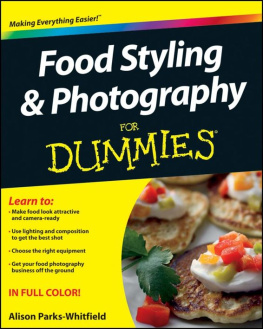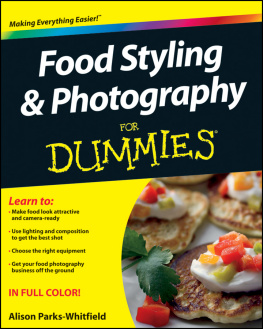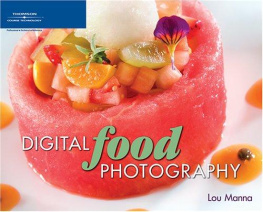Essential Lessons for Creating Picture-Perfect Dishes
THE ULTIMATE GUIDE TO
Food Styling
JULIA KONOVALOVA
Creator of Imagelicious

The author and publisher have provided this e-book to you for your personal use only. You may not make this e-book publicly available in any way. Copyright infringement is against the law. If you believe the copy of this e-book you are reading infringes on the authors copyright, please notify the publisher at: http://us.macmillanusa.com/piracy.
for MY MOM
I remember the exact moment I decided I was a food photographer. Looking back to 2008, I now laugh and cringe at my photos. Yet back then, I was extremely proud of them. So, yes, one day I just decided I was a food photographer and started offering my food photography and food styling services.
I was still in my twenties and pretty naive. That naivete and innocence made me feel invincible. I didnt have imposter syndromefunny enough, I have it nowand I felt like I could conquer the world with my art.
Thats how I became a food photographernot because I was amazing or even just marginally good at it, but because that was what I decided I wanted to be.
Over the years, Ive done dozens and dozens of photoshoots for various brands and clients. Ive shot a cookbook, menus, national advertising campaigns, and many more amazing and fun projects.
My food styling and photography style evolved, and it continues to evolve and grow every day. I learn and study food photography week after week. I analyze photos that I like and look at magazines to study their styling. I experiment and practice.
Somewhere in the last 15 years, I took a small detour from being exclusively a photographer and started a food blog. It helped me understand the science of cooking and how ingredients interact with each other. Knowing and loving how to cook isnt a requirement for food photography, but it helps a lot when styling recipes and ingredients for food.
In tumultuous 2020, I decided to go back to photography and slightly changed my style. I went from light and airy to dark and moody. I still love both styles and photograph with different techniques for various clients.
That dark and moody style, however, really helped me grow my Instagram account. All of the sudden, I was bombarded by messages in my inbox asking advice about food styling and photography. I found myself composing answers to all the food styling questions in my head. I dissected what I do and how I do it, and it turned out that, even though theres no specific formula for a beautifully styled food photo, there are definitely enough techniques that could be mixed and matched to create a gorgeous image.

How to Use This Book
In the first part of the book, Ill be talking about the basics or pillars of food stylingthings like composition, layering, colors, and props. These chapters will have a lot of information (I do love to talk, so it may have more words than you bargained for) with supporting photos and explanations of how and why some of these techniques are used. In the second part of the book, Ill dive into more practical concepts of food styling like working with brands or cooking with food styling in mind. Ill share a little bit about shadows and light and dark food photography. This is not a technical food photography book, but these concepts are important when working on your own food styling. Finally, in the third part of the book, Ill take you through the actual step-by-step process of styling different kinds of foods while applying some of the basic techniques from the first two parts.
From my own experience, I know how difficult it is to visualize some of the generic advice like: Make sure that the colors work or Dont forget to use the layering technique when creating an image or Use the compositional grid to setup the props. These are all great pieces of advice, but when Im standing in front of a plate of pancakes, the suggestion of using a layering technique is too generic. Do I layer the pancakes on top of each other? Do I layer plates? Where do I position the props? How are compositional grids even applied?
So, in this book, Ill go through the explanation of how and why certain decisions in the food styling were made, what thought process went through my head, and how the photo evolved from the beginning until the end. My goal is that by reading what specifically was changed from step to step and why those changes were made, youll be able to adapt and use the same ideas and techniques for your beautiful photographs.
All the rules and techniques that I will be describing arent absolute. I go against them all the time. Whenever I say that something looks best from this angle or styled a certain way, it does not mean that it is the one and only way to go about ityou can absolutely use a different angle and a different style. All I mean is that this is the way that works most of the time. Its an easy starting point. A decision made by me works for me and may not work for you. Beauty is subjective, so your choices in styling and mine will be different. That is ok. In fact, it is great! We dont want uniformity. We want photos to represent each of us and our styles. But it is always great to know and understand the basics to help when you are stuck and to rely on when needed.
Youll also notice that photos in this book vary in style and complexity. Some are dark, some light. Some have only a few props and some have complex and involved prop setups. I wanted to show how all the techniques and ideas described in the book could be applied to a variety of food photography styles to suit different moods and ideas.
I poured my heart and soul into this book. I shared every tip and trick I know. My hope, my wish, is that I help you in this wonderful, beautiful, and delicious food styling and food photography journey.
Basics are important. Without an understanding of basic concepts, it is difficult to create a compelling food photo. In this section, youll learn all the basic concepts and techniques used for food styling. Its these pillars that make up beautiful and delicious food pictures. They dont all need to be used at the same time. You can pick and choose different techniques and ideas, but without knowing them, youll be blindly stumbling and guessing your way through a scene setup. Knowing these concepts will help you identify what works, what doesnt, and, more importantly, how to change and adapt to create a more cohesive image.
















